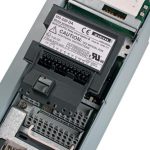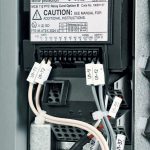Die Umrichter der Serie VLT AutomationDrive FC 302 sind mit einem durch die PTB zertifizierten PTC-Modul ausge-stattet und sind damit in der Lage, den Alleinschutz eines EEx-d-Motors innerhalb der Anlage zu übernehmen. The converters in the VLT AutomationDrive FC 302 series are fitted with a PTB-certified PTC module that enables them to provide stand-alone protection for an EEx-d motor in the installation.
Falko Wiehle
Ist bei der Umrüstung oder Neuinstallation einer Anlage der Entschluss für einen drehzahlgeregelten Antrieb gefallen, ist auch der Einbauort von Interesse. Steht der Motor in einem explosionsgefährdeten Produktionsbereich, so kommt ein Motor mit druckfester Kapselung und gegebenenfalls Klemmkasten mit erhöhter Sicherheit zum Einsatz. Gemäß EN 60079 ist der Einsatz von in der Wicklung eingebauten PTC-Fühlern als Übertemperaturschutz, die Teil der Ex-Zulassung des Motors sind, erforderlich. In aller Regel erfolgt die Überwachung über PTC-Auswertegeräte. Diese müssen einen für die Auswertung der im Ex-Bereich stehenden Motoren zertifizierten Sensorkreis aufweisen, an den die PTC-Sensoren anzuschließen sind. Das Auswerterelais ist in den Steuerstromkreis des Hauptschützes zu integrieren, um bei unzulässigen Temperaturen die Energiezufuhr zu unterbinden. Ein Stop-Befehl zum Frequenzumrichter kann im Einzelfall erforderlich sein. Zudem ist der von außen wirkende Reset des ausgelösten Relais zu berücksichtigen.
Die Rückmeldung des Relais zum Prozessleitsystem für den Grund des Ausfalls erfolgt mittels eines weiteren potenzialfreien Kontaktes. Der Frequenzumrichter sitzt zum Beispiel in einem Montagegestell unweit des Einspeisefeldes und erfährt seine Ansteuerung über Profibus. Überwachung und Ansteuerung der Antriebseinheit gliedern sich in die Profibussignale, die Ansteuerung des hier obligatorischen Hauptschützes, die Rückmeldungen des PTC-Auswerterelais sowie dessen Reset. Hinzu kommen der im Schaltraum möglicherweise gestreute Einbau des Frequenzumrichters, des Abgangsfeldes mit PTC-Auswertung, sowie die Hilfsspannungsversorgung für die Profibusschnittstelle des Umrichters, um beim Abschalten des Antriebs den Profibus weiterhin verfügbar zu halten. Der Verdrahtungsaufwand ist auf die Leistungsverdrahtung zwischen Einspeisefeld, Frequenzumrichter und Motor, Hilfsspannungsversorgung des Umrichters, Profibuskabel, jeweils eigenes Signalkabel für Schütz, PTC-Rückmeldung, PTC-Sensor und gegebenenfalls Hilfsspannung des PTC-Auswertegerätes zu beziffern.
Alleinschutz für den Motor
Sind die für den Explosionsschutz relevanten Funktionen im Frequenzumrichter integriert, lässt sich der Aufwand reduzieren. Durch eine Atex-zertifizierte PTC-Auswerteelektronik in Verbindung mit einer ebenfalls zertifizierten und sicheren Möglichkeit, die Energie zum Motor abzuschalten, ist die Grundfunktion der Motorüberwachung im explosionsgefährdeten Bereich gesichert. Kommt zu dieser Funktionalität die Profibusanbindung hinzu, und steht die PTC-Auswertung als internes, auswertbares Signal des Frequenzumrichters zur Verfügung, verringert sich der Aufwand an Signalleitungen, Montage und Schnittstellenplanung merklich. Die gesicherte Unterbindung der Energiezufuhr zum Motor durch geräteinternes redundantes Abschalten der IGBT-Zündstufenversorgung und gleichzeitiger Zündimpulssperre macht die Verwendung eines Hauptschützes, eines Koppelrelais und der erforderlichen Steuerspannungssicherung im Einspeisefeld überflüssig. Der Sicherungslasttrenner als Freischalte- und Leitungsschutzorgan bleibt als alleiniges Bauteil im Einspeisefeld erhalten. Die Hilfsspannungsversorgung für den Profibus versorgt zusätzlich die in Form eines Moduls implementierte PTC-Auswertung. Die Auswertung der Signale ebenso wie das Ansteuern des Antriebs erfolgt nun vollständig über Profibus. Dies spart Signalverkabelung für PTC-Auswertung, Ansteuerung des Hauptschützes, Montage- und Planungskosten sowie Digitaleingangs- und -ausgangsbaugruppenbelegung im Prozessleitsystem ebenso wie die Hardware selbst ein. Im Fehlerfalle reduziert die kompakte Anordnung die Örtlichkeiten des möglichen Fehlerauftritts erheblich, nämlich nur noch auf den Motor selbst, die Verdrahtung der PTC-Sensoren und des Frequenzumrichters.
Gemeinsam mit Ziehl hat Danfoss ein PTC-Modul für den VLT-AutomationDrive FC 302 entwickelt. Das Modul besitzt die Zertifizierung der PTB. Damit ist der Frequenzumrichter FC 302 in der Lage, den Alleinschutz eines EEx-d-Motors innerhalb der Anlage zu übernehmen. Das Modul ist geeignet, PTC nach DIN 44081 und DIN 44082 anzuschließen und zu überwachen. Die Überwachung des Fühlerkreises auf Kurzschluss und Leitungsbruch ist selbstverständlich. Durch Nutzung der Safe Torque Off (STO)-Funktion gemäß EN 61800–5–2 (Kategorie SIL 2) kann eine Netztrennung mittels Schütz entfallen. Dabei wird die Sicherheit innerhalb der Anlage vollständig unterstützt. Das Display des Frequenzumrichters zeigt dem Bediener bei Auslösung des Motorschutzes eine entsprechende Fehlermeldung an. Die STO kann durch externe Überwachungskomponenten weiterhin genutzt werden. Der FC 302 gibt durch intelligente Auswertung die richtige Diagnose aus und verkürzt somit Fehlersuche und -behebung.
Once the decision has been made to use a speed-controlled drive for upgrades or new installations in chemical industry plant, the installation location is a significant factor. If the motor is located in a potentially hazardous production area, it is essential to use a motor with a sealed enclosure and, if appropriate, terminal boxes with an elevated safety rating. In accordance with the EN 60079 standard, PTC sensors embedded in the motor winding to provide overtemperature protection must be used as part of motor approval for use in hazardous areas. Monitoring is usually performed via PTC tripping units. They must have a sensor circuit certified for monitoring of the motor located in the hazardous area, to which the PTC sensors are to be connected. The tripping relay must be integrated in the control circuit of the main contactor in order to disconnect the power source if the temperature exceeds the allowable range. In some cases, a stop command to the frequency converter may be necessary. In addition, provision must be made for an external reset of the tripped relay.
Feedback from the relay to the process control system to indicate the reason for the out-of-service state is provided by a separate, potential-free contact. For example, the frequency converter may be located in a mounting frame near the supply panel and be controlled via Profibus. The monitoring and control of the drive unit can be broken down into the Profibus signals, the control signal for the main contactor that is obligatory in this case, the feedback signals from the PTC tripping relay, and the relay reset. Additional factors are the possibly distributed installation of the frequency converter in the switch room, the output panel with PTC tripping unit, and the auxiliary power supply for the converter Profibus interface to maintain the availability of the Profibus when the drive is destaged. The wiring cost must be estimated based on the power cabling between the supply panel, frequency converter and motor, the aux-iliary power supply for the converter, the Profibus cable, one signal cable each for the contactor, PTC feedback and PTC sensor, and the auxiliary supply voltage for the PTC tripping unit if necessary.
Stand-alone motor protection
The basic function of monitoring the motor in a hazardous area is also ensured by the combination of an Atex-certified electronic PTC tripping unit integrated into the frequency converter and a means of destaging power to the motor, which is also certified and reliable. If this function is augmented by a Profibus link and the PTC tripping function is available in the form of a signal that can be evaluated inside the frequency converter, the cost of signal lines, installation and interface planning is distinctly reduced. Secure disconnection of the power supply to the motor, which is achieved redundantly inside the unit by destaging the supply voltage of the IGBT trigger stage and at the same time blocking the trigger pulses, elimi-nates the need for a main contactor, any coupling relay, and the control voltage protective devices normally fitted on the supply panel. The circuit breaker, which acts as a de-energising and wiring protection device, is the only component still required on the supply panel. The aux-iliary power supply for the Profibus also powers the PTC tripping unit, which is implemented as a module. Now signal evaluation and drive control take place entirely via the Profibus. This eliminates signal cabling for PTC monitoring and main contactor control, reduces planning and installation costs, reduces the number of digital input and output module in the process control system, and even reduces the amount of hardware. If a fault occurs, the compact arrangement reduces the number of places where a fault can occur: namely in the motor, the wiring of the PTC sensors, and the frequency converter.
In cooperation with Ziehl, Danfoss has developed a PTC module for the VLT AutomationDrive FC 302. This module is PTB certified. With it, the FC 302 can provide stand-alone protection for an EEx-d motor within the installation. The module is suitable for connection to and monitoring of PTC sensors compliant with DIN 44081 and DIN 44082. Naturally, the sensor circuit is also monitored for short-circuit and broken-wire conditions. With the utilisation of the Safe Torque Off (STO) function integrated in the FC 302 series, which complies with EN 61800–5–2 (Category SIL 2), AC mains disconnection using a contactor is no longer required. The frequency converter display shows a suitable error message if the motor protection is tripped. The STO can continue to be used by external monitoring components. The FC 302 uses intelligent evaluation to issue the right diagnosis, which reduces troubleshooting and repair times.
Top Products 401
VLT-Frequenzumrichter
PCT-Modul
SPS/IPC/Drives 2008
Unsere Webinar-Empfehlung
Der Webcast MTP und modulare Produktion bietet eine einzigartige Gelegenheit, mehr über die aktuellen Entwicklungen bei MTP und in der modularen Produktion zu erfahren.
Chemie- und Pharmaproduktion braucht mehr Flexibilität
In der heutigen sich schnell wandelnden Welt stehen…
Teilen:













